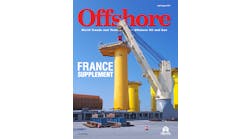SeaScope provides early warning, tracking and analysis of offshore slicks
CGG has introduced SeaScope, a pollution monitoring solution for offshore environments.
The service combines remote sensing science with Earth observation data, machine learning, and high-performance computing to provide sea-surface slick intelligence. This can be used to improve situational awareness of the interaction between offshore assets, coastal facilities, local vessel activity, and the natural marine environment.
Pollution incidents present a significant risk to offshore operations as any resulting environmental impact can have far-reaching reputational, as well as cost, implications. SeaScope alerts of unusual slicks or discharges by offering early detection and qualification of anomalous pollution, helping to accelerate response times and thereby minimize the potential impact.
According to Peter Whiting, EVP, Geoscience at CGG: “SeaScope capitalizes on our 25 years of experience in advanced data processing and analysis of satellite data. Its value lies not only in helping offshore industries to respond quickly to events, but also to mitigate risks and support their environmental and operational transparency measures, and related ESG commitments.”
The service, developed by CGG Satellite Mapping with support from ESA Space Solutions, integrates two types of space assets: EO imagery and satellite-derived ship location (AIS) data. Specialists at CGG interpret the EO imagery to monitor the ocean surface for offshore slicks and determine their extent.
AIS data provides knowledge of ship locations and activity and is used to link slicks with vessels in the area. According to the company, combining these technologies generates reliable alerts on anomalous events to offshore infrastructure operators, enhancing their ability to understand the occurrence and evolving behavior of nearby pollution events.
SeaScope was created between 2018 and 2020 as a demonstration project as part of the ESA Space Solutions Integrated Applications Promotion (IAP) program. Over 3,020 medium and high-resolution satellite radar scenes were processed and interpreted across infrastructure in the North Sea, Gulf of Mexico, and offshore Southeast Asia.
A key capability proven in the demo project was the provision of standard geospatial data with clear reporting statistics to emergency response teams, who often have responsibility for multiple offshore assets globally. End-users receive targeted information supported by clear visual data showing the location and extent of any slicks via software-agnostic geospatial deliverables for in-house systems or an intuitive online portal.
For energy companies with offshore assets, the proactive monitoring is said to allow the establishment of production water baselines associated with routine operations. By providing early detection of anomalous events and third-party pollution incidents, as well as surveillance of natural seeps, the service also supports creation of a growing evidence base of responsible operations for operators, regulators, investors and insurers, ensuring a transparent record of responsible activity.
“SeaScope delivers a highly scalable remote monitoring solution to identify individual offshore pollution events or to verify clean activities across global asset portfolios. The CGG team will continue to develop the analytics surrounding the growing SeaScope database to provide further insights for user clients,” said Whiting.
The SeaScope project teams operate from offices in Edenbridge, UK, Massy, France, and Houston.
![Vessel pollution in the Red Sea captured by the ESA Sentinel-1 satellite (contains modified Copernicus Sentinel data [2021]). Vessel pollution in the Red Sea captured by the ESA Sentinel-1 satellite (contains modified Copernicus Sentinel data [2021]).](https://img.offshore-mag.com/files/base/ebm/os/image/2021/07/2108OFFseas_p01.60e893abe5213.png?auto=format,compress&fit=crop&q=45&w=250&width=250)


